MKTG801: Lion's International Marketing Plan for India Expansion
VerifiedAdded on 2023/06/03
|32
|8169
|476
Report
AI Summary
This comprehensive report outlines an international marketing plan for Lion, an Australian food and beverage company, aiming to expand into the Indian market. It begins with an executive summary and table of contents, followed by a detailed introduction to Lion and its objectives. The report employs secondary research methodologies for situational analysis, including company and market analyses, assessing the political, economic, social, and technological environments in India. It also incorporates a SWOT analysis to evaluate internal strengths and weaknesses alongside external opportunities and threats. The plan then establishes specific international and market objectives, recommending a target market identification, segmentation strategy, and market positioning. The recommended marketing mix strategy covers product/service, place (distribution), price, and promotion strategies, along with a budget and implementation plan. The report concludes with a discussion of the findings, referencing relevant literature throughout.
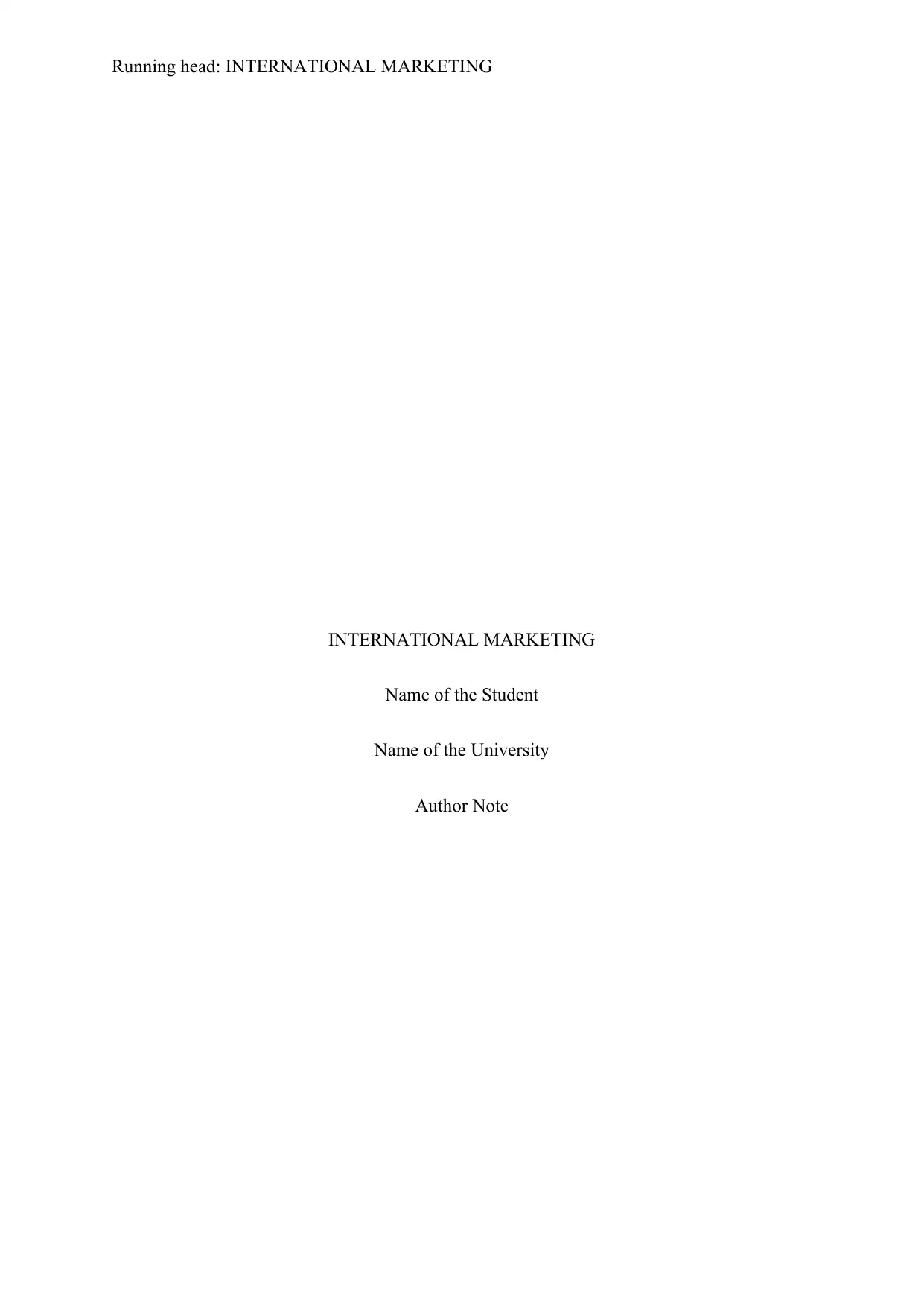
Running head: INTERNATIONAL MARKETING
INTERNATIONAL MARKETING
Name of the Student
Name of the University
Author Note
INTERNATIONAL MARKETING
Name of the Student
Name of the University
Author Note
Paraphrase This Document
Need a fresh take? Get an instant paraphrase of this document with our AI Paraphraser
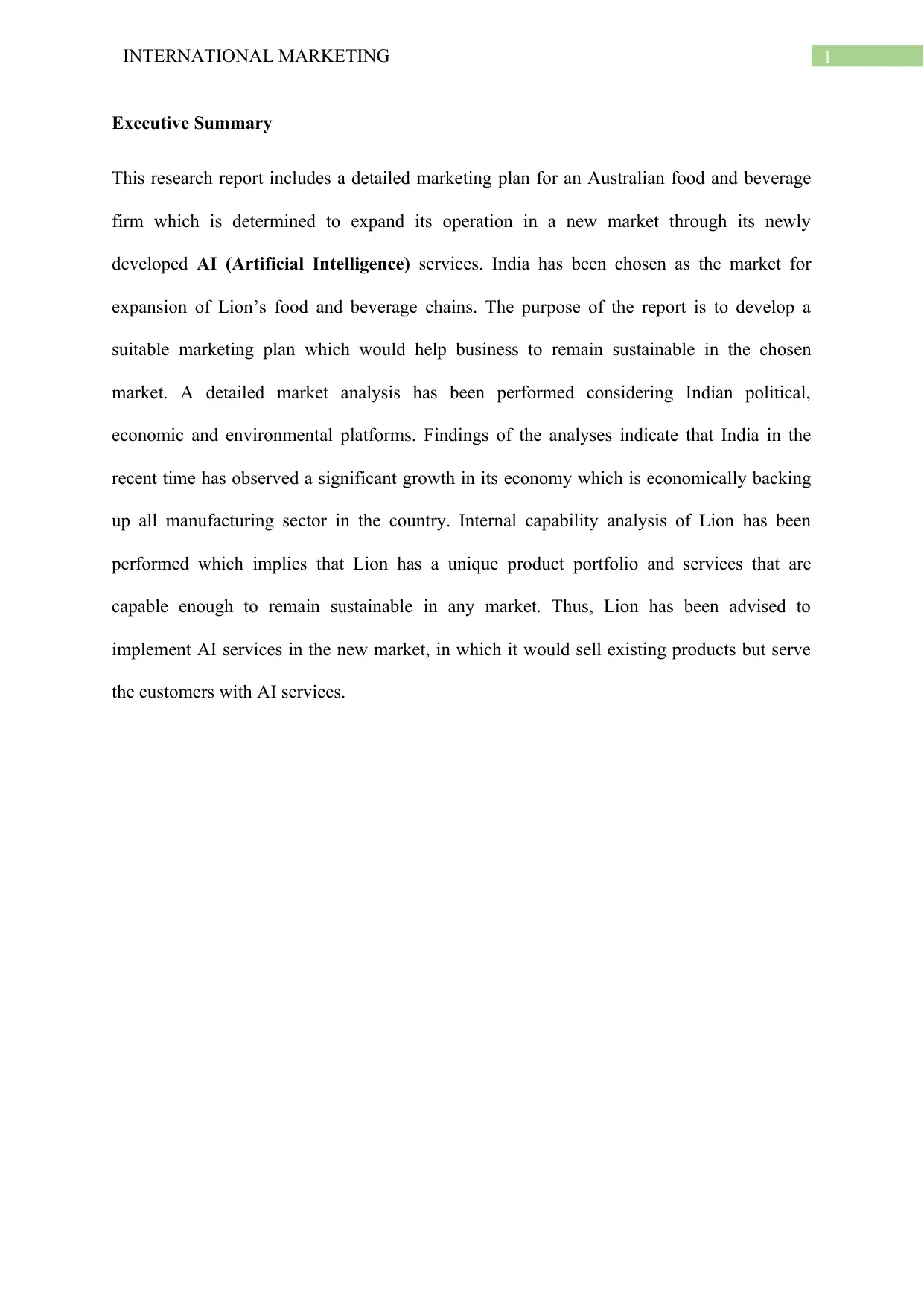
1INTERNATIONAL MARKETING
Executive Summary
This research report includes a detailed marketing plan for an Australian food and beverage
firm which is determined to expand its operation in a new market through its newly
developed AI (Artificial Intelligence) services. India has been chosen as the market for
expansion of Lion’s food and beverage chains. The purpose of the report is to develop a
suitable marketing plan which would help business to remain sustainable in the chosen
market. A detailed market analysis has been performed considering Indian political,
economic and environmental platforms. Findings of the analyses indicate that India in the
recent time has observed a significant growth in its economy which is economically backing
up all manufacturing sector in the country. Internal capability analysis of Lion has been
performed which implies that Lion has a unique product portfolio and services that are
capable enough to remain sustainable in any market. Thus, Lion has been advised to
implement AI services in the new market, in which it would sell existing products but serve
the customers with AI services.
Executive Summary
This research report includes a detailed marketing plan for an Australian food and beverage
firm which is determined to expand its operation in a new market through its newly
developed AI (Artificial Intelligence) services. India has been chosen as the market for
expansion of Lion’s food and beverage chains. The purpose of the report is to develop a
suitable marketing plan which would help business to remain sustainable in the chosen
market. A detailed market analysis has been performed considering Indian political,
economic and environmental platforms. Findings of the analyses indicate that India in the
recent time has observed a significant growth in its economy which is economically backing
up all manufacturing sector in the country. Internal capability analysis of Lion has been
performed which implies that Lion has a unique product portfolio and services that are
capable enough to remain sustainable in any market. Thus, Lion has been advised to
implement AI services in the new market, in which it would sell existing products but serve
the customers with AI services.
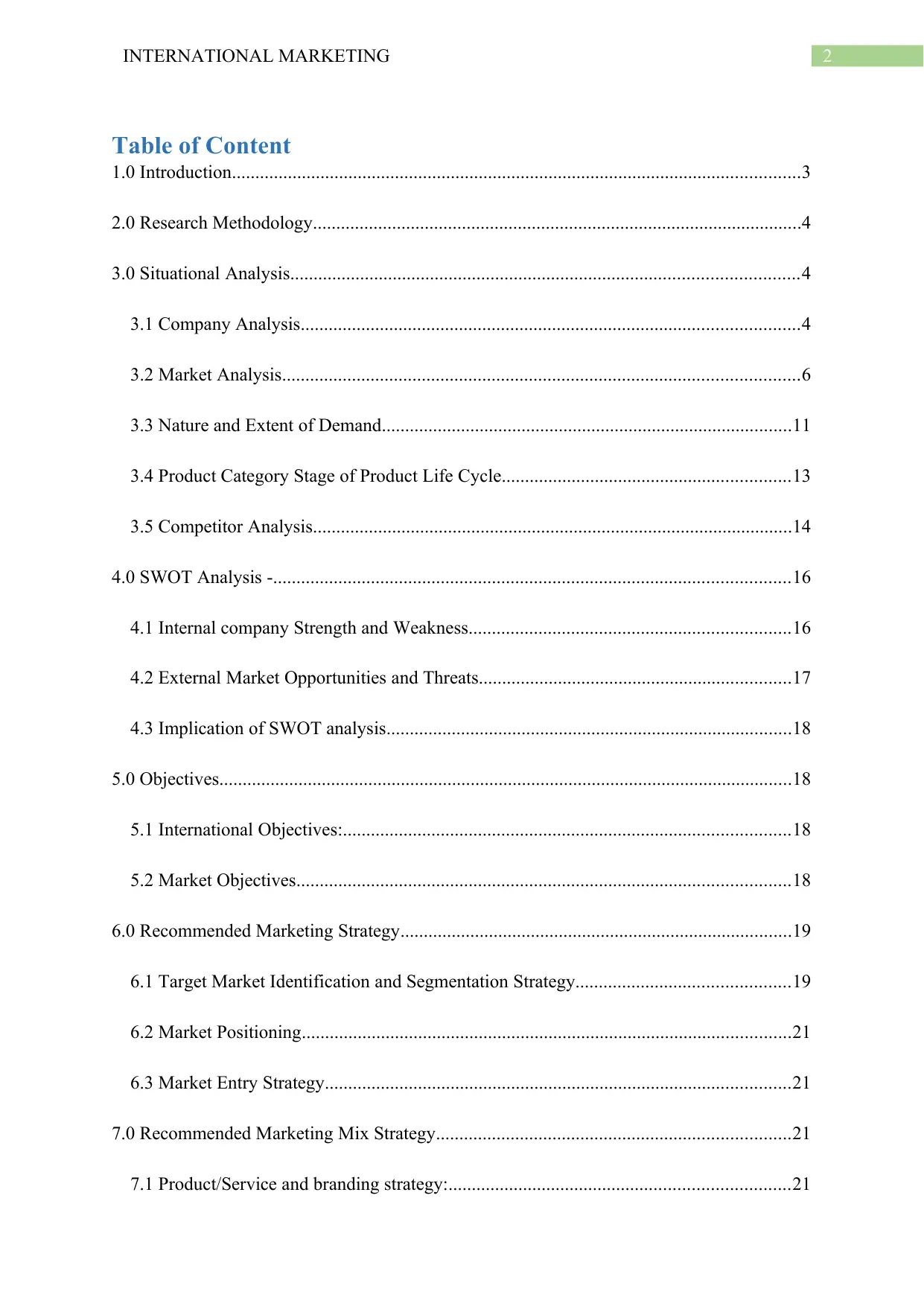
2INTERNATIONAL MARKETING
Table of Content
1.0 Introduction..........................................................................................................................3
2.0 Research Methodology.........................................................................................................4
3.0 Situational Analysis.............................................................................................................4
3.1 Company Analysis...........................................................................................................4
3.2 Market Analysis...............................................................................................................6
3.3 Nature and Extent of Demand........................................................................................11
3.4 Product Category Stage of Product Life Cycle..............................................................13
3.5 Competitor Analysis.......................................................................................................14
4.0 SWOT Analysis -...............................................................................................................16
4.1 Internal company Strength and Weakness.....................................................................16
4.2 External Market Opportunities and Threats...................................................................17
4.3 Implication of SWOT analysis.......................................................................................18
5.0 Objectives...........................................................................................................................18
5.1 International Objectives:................................................................................................18
5.2 Market Objectives..........................................................................................................18
6.0 Recommended Marketing Strategy....................................................................................19
6.1 Target Market Identification and Segmentation Strategy..............................................19
6.2 Market Positioning.........................................................................................................21
6.3 Market Entry Strategy....................................................................................................21
7.0 Recommended Marketing Mix Strategy............................................................................21
7.1 Product/Service and branding strategy:.........................................................................21
Table of Content
1.0 Introduction..........................................................................................................................3
2.0 Research Methodology.........................................................................................................4
3.0 Situational Analysis.............................................................................................................4
3.1 Company Analysis...........................................................................................................4
3.2 Market Analysis...............................................................................................................6
3.3 Nature and Extent of Demand........................................................................................11
3.4 Product Category Stage of Product Life Cycle..............................................................13
3.5 Competitor Analysis.......................................................................................................14
4.0 SWOT Analysis -...............................................................................................................16
4.1 Internal company Strength and Weakness.....................................................................16
4.2 External Market Opportunities and Threats...................................................................17
4.3 Implication of SWOT analysis.......................................................................................18
5.0 Objectives...........................................................................................................................18
5.1 International Objectives:................................................................................................18
5.2 Market Objectives..........................................................................................................18
6.0 Recommended Marketing Strategy....................................................................................19
6.1 Target Market Identification and Segmentation Strategy..............................................19
6.2 Market Positioning.........................................................................................................21
6.3 Market Entry Strategy....................................................................................................21
7.0 Recommended Marketing Mix Strategy............................................................................21
7.1 Product/Service and branding strategy:.........................................................................21
⊘ This is a preview!⊘
Do you want full access?
Subscribe today to unlock all pages.

Trusted by 1+ million students worldwide
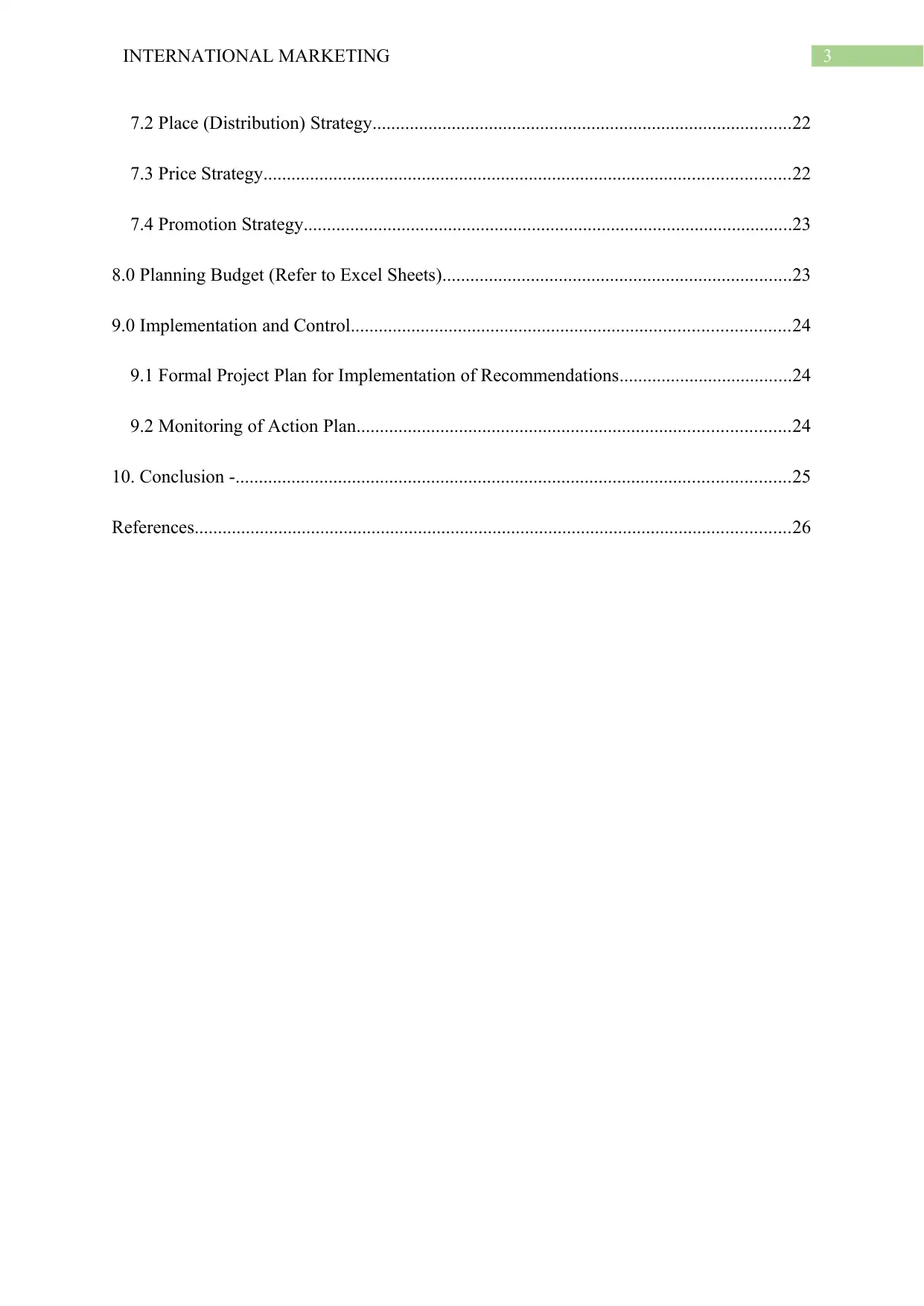
3INTERNATIONAL MARKETING
7.2 Place (Distribution) Strategy..........................................................................................22
7.3 Price Strategy.................................................................................................................22
7.4 Promotion Strategy.........................................................................................................23
8.0 Planning Budget (Refer to Excel Sheets)...........................................................................23
9.0 Implementation and Control..............................................................................................24
9.1 Formal Project Plan for Implementation of Recommendations.....................................24
9.2 Monitoring of Action Plan.............................................................................................24
10. Conclusion -.......................................................................................................................25
References................................................................................................................................26
7.2 Place (Distribution) Strategy..........................................................................................22
7.3 Price Strategy.................................................................................................................22
7.4 Promotion Strategy.........................................................................................................23
8.0 Planning Budget (Refer to Excel Sheets)...........................................................................23
9.0 Implementation and Control..............................................................................................24
9.1 Formal Project Plan for Implementation of Recommendations.....................................24
9.2 Monitoring of Action Plan.............................................................................................24
10. Conclusion -.......................................................................................................................25
References................................................................................................................................26
Paraphrase This Document
Need a fresh take? Get an instant paraphrase of this document with our AI Paraphraser
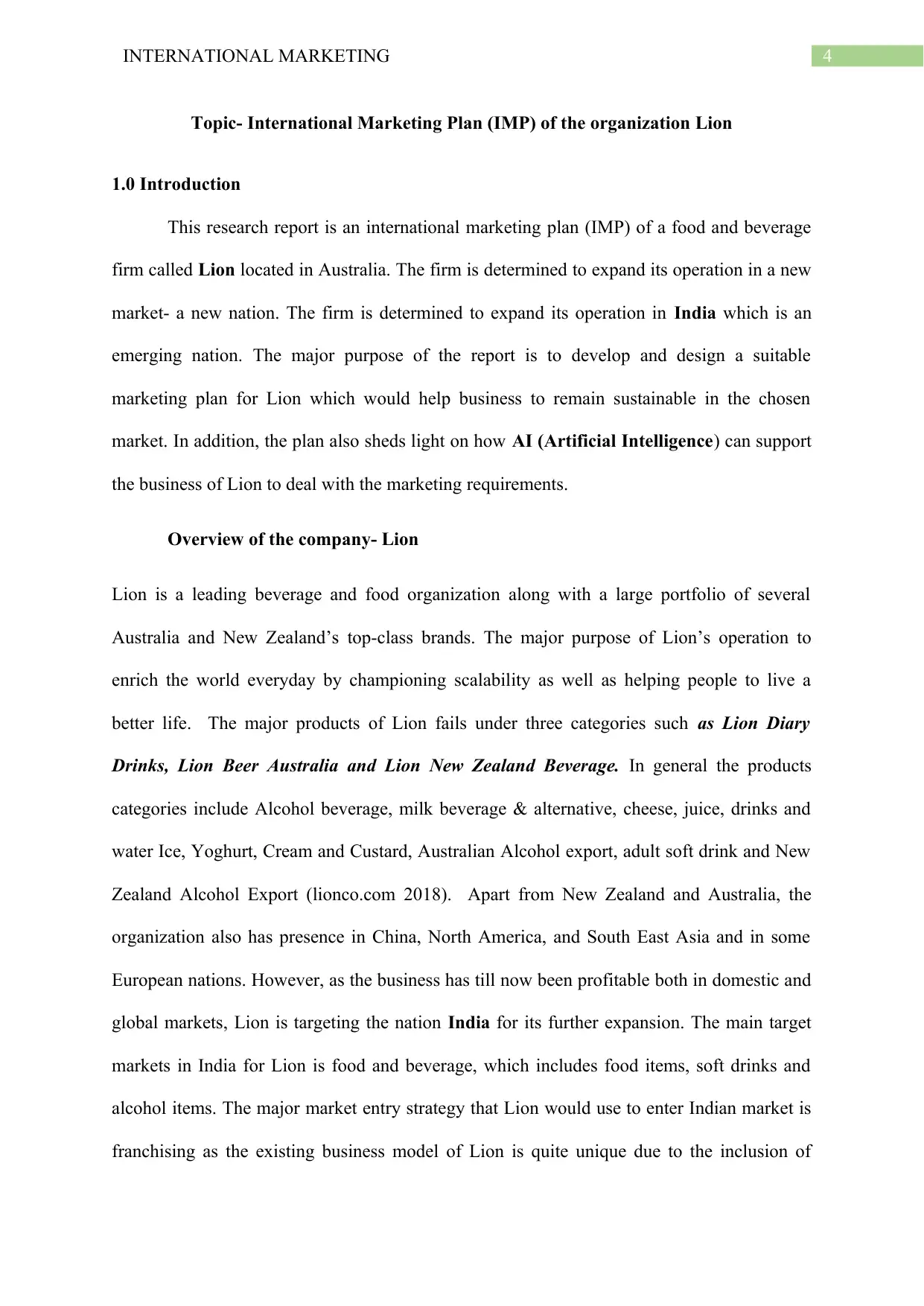
4INTERNATIONAL MARKETING
Topic- International Marketing Plan (IMP) of the organization Lion
1.0 Introduction
This research report is an international marketing plan (IMP) of a food and beverage
firm called Lion located in Australia. The firm is determined to expand its operation in a new
market- a new nation. The firm is determined to expand its operation in India which is an
emerging nation. The major purpose of the report is to develop and design a suitable
marketing plan for Lion which would help business to remain sustainable in the chosen
market. In addition, the plan also sheds light on how AI (Artificial Intelligence) can support
the business of Lion to deal with the marketing requirements.
Overview of the company- Lion
Lion is a leading beverage and food organization along with a large portfolio of several
Australia and New Zealand’s top-class brands. The major purpose of Lion’s operation to
enrich the world everyday by championing scalability as well as helping people to live a
better life. The major products of Lion fails under three categories such as Lion Diary
Drinks, Lion Beer Australia and Lion New Zealand Beverage. In general the products
categories include Alcohol beverage, milk beverage & alternative, cheese, juice, drinks and
water Ice, Yoghurt, Cream and Custard, Australian Alcohol export, adult soft drink and New
Zealand Alcohol Export (lionco.com 2018). Apart from New Zealand and Australia, the
organization also has presence in China, North America, and South East Asia and in some
European nations. However, as the business has till now been profitable both in domestic and
global markets, Lion is targeting the nation India for its further expansion. The main target
markets in India for Lion is food and beverage, which includes food items, soft drinks and
alcohol items. The major market entry strategy that Lion would use to enter Indian market is
franchising as the existing business model of Lion is quite unique due to the inclusion of
Topic- International Marketing Plan (IMP) of the organization Lion
1.0 Introduction
This research report is an international marketing plan (IMP) of a food and beverage
firm called Lion located in Australia. The firm is determined to expand its operation in a new
market- a new nation. The firm is determined to expand its operation in India which is an
emerging nation. The major purpose of the report is to develop and design a suitable
marketing plan for Lion which would help business to remain sustainable in the chosen
market. In addition, the plan also sheds light on how AI (Artificial Intelligence) can support
the business of Lion to deal with the marketing requirements.
Overview of the company- Lion
Lion is a leading beverage and food organization along with a large portfolio of several
Australia and New Zealand’s top-class brands. The major purpose of Lion’s operation to
enrich the world everyday by championing scalability as well as helping people to live a
better life. The major products of Lion fails under three categories such as Lion Diary
Drinks, Lion Beer Australia and Lion New Zealand Beverage. In general the products
categories include Alcohol beverage, milk beverage & alternative, cheese, juice, drinks and
water Ice, Yoghurt, Cream and Custard, Australian Alcohol export, adult soft drink and New
Zealand Alcohol Export (lionco.com 2018). Apart from New Zealand and Australia, the
organization also has presence in China, North America, and South East Asia and in some
European nations. However, as the business has till now been profitable both in domestic and
global markets, Lion is targeting the nation India for its further expansion. The main target
markets in India for Lion is food and beverage, which includes food items, soft drinks and
alcohol items. The major market entry strategy that Lion would use to enter Indian market is
franchising as the existing business model of Lion is quite unique due to the inclusion of
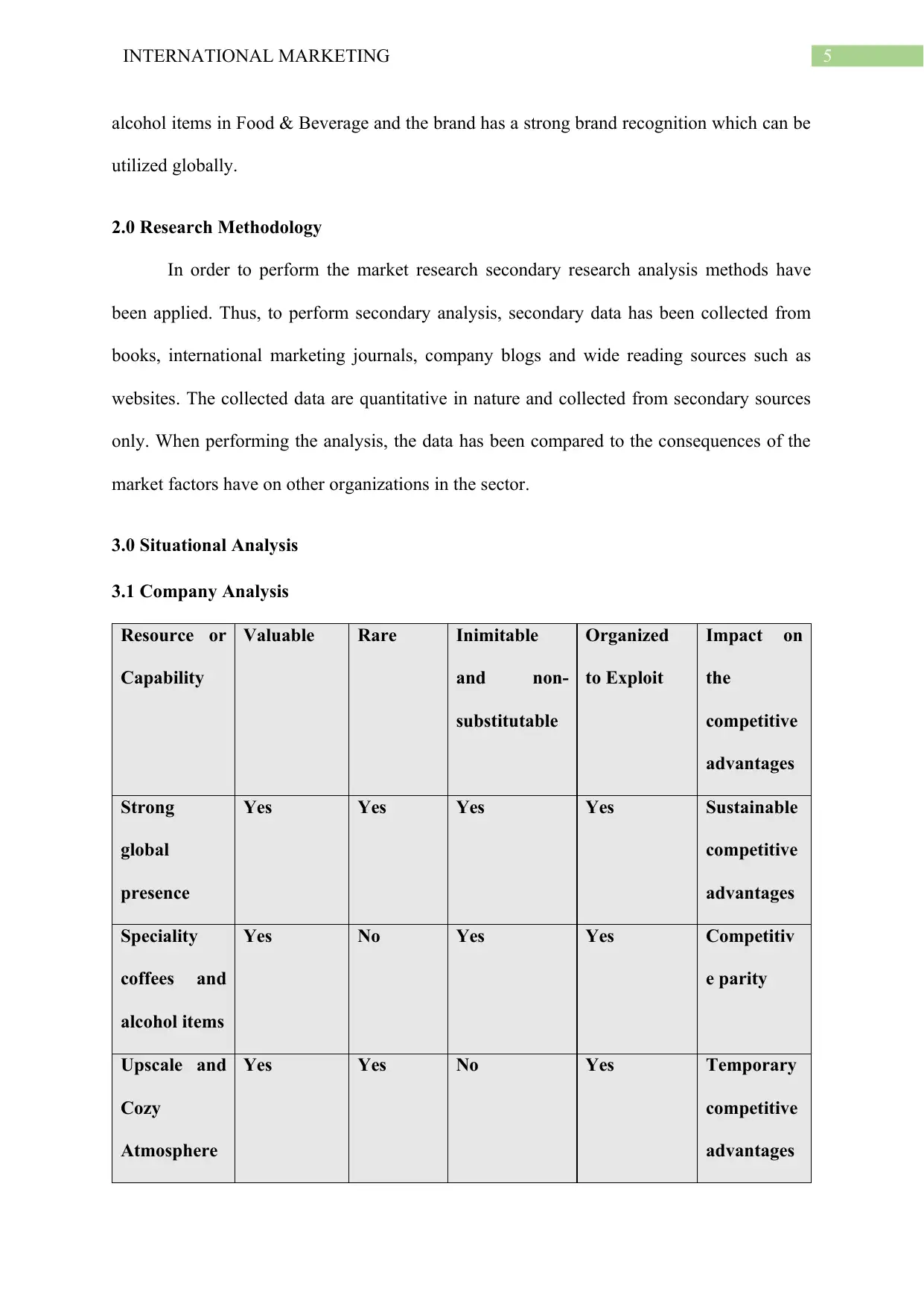
5INTERNATIONAL MARKETING
alcohol items in Food & Beverage and the brand has a strong brand recognition which can be
utilized globally.
2.0 Research Methodology
In order to perform the market research secondary research analysis methods have
been applied. Thus, to perform secondary analysis, secondary data has been collected from
books, international marketing journals, company blogs and wide reading sources such as
websites. The collected data are quantitative in nature and collected from secondary sources
only. When performing the analysis, the data has been compared to the consequences of the
market factors have on other organizations in the sector.
3.0 Situational Analysis
3.1 Company Analysis
Resource or
Capability
Valuable Rare Inimitable
and non-
substitutable
Organized
to Exploit
Impact on
the
competitive
advantages
Strong
global
presence
Yes Yes Yes Yes Sustainable
competitive
advantages
Speciality
coffees and
alcohol items
Yes No Yes Yes Competitiv
e parity
Upscale and
Cozy
Atmosphere
Yes Yes No Yes Temporary
competitive
advantages
alcohol items in Food & Beverage and the brand has a strong brand recognition which can be
utilized globally.
2.0 Research Methodology
In order to perform the market research secondary research analysis methods have
been applied. Thus, to perform secondary analysis, secondary data has been collected from
books, international marketing journals, company blogs and wide reading sources such as
websites. The collected data are quantitative in nature and collected from secondary sources
only. When performing the analysis, the data has been compared to the consequences of the
market factors have on other organizations in the sector.
3.0 Situational Analysis
3.1 Company Analysis
Resource or
Capability
Valuable Rare Inimitable
and non-
substitutable
Organized
to Exploit
Impact on
the
competitive
advantages
Strong
global
presence
Yes Yes Yes Yes Sustainable
competitive
advantages
Speciality
coffees and
alcohol items
Yes No Yes Yes Competitiv
e parity
Upscale and
Cozy
Atmosphere
Yes Yes No Yes Temporary
competitive
advantages
⊘ This is a preview!⊘
Do you want full access?
Subscribe today to unlock all pages.

Trusted by 1+ million students worldwide
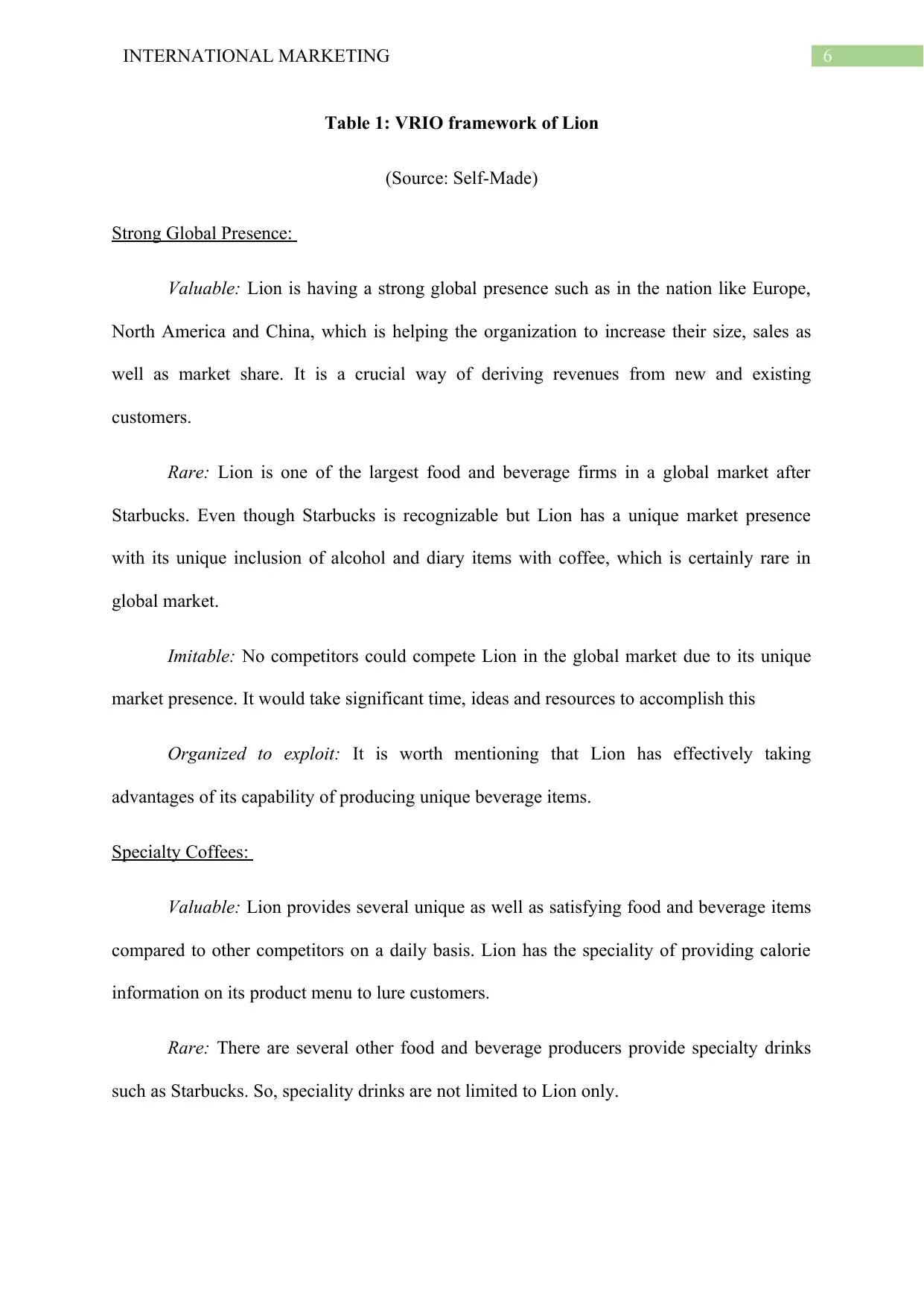
6INTERNATIONAL MARKETING
Table 1: VRIO framework of Lion
(Source: Self-Made)
Strong Global Presence:
Valuable: Lion is having a strong global presence such as in the nation like Europe,
North America and China, which is helping the organization to increase their size, sales as
well as market share. It is a crucial way of deriving revenues from new and existing
customers.
Rare: Lion is one of the largest food and beverage firms in a global market after
Starbucks. Even though Starbucks is recognizable but Lion has a unique market presence
with its unique inclusion of alcohol and diary items with coffee, which is certainly rare in
global market.
Imitable: No competitors could compete Lion in the global market due to its unique
market presence. It would take significant time, ideas and resources to accomplish this
Organized to exploit: It is worth mentioning that Lion has effectively taking
advantages of its capability of producing unique beverage items.
Specialty Coffees:
Valuable: Lion provides several unique as well as satisfying food and beverage items
compared to other competitors on a daily basis. Lion has the speciality of providing calorie
information on its product menu to lure customers.
Rare: There are several other food and beverage producers provide specialty drinks
such as Starbucks. So, speciality drinks are not limited to Lion only.
Table 1: VRIO framework of Lion
(Source: Self-Made)
Strong Global Presence:
Valuable: Lion is having a strong global presence such as in the nation like Europe,
North America and China, which is helping the organization to increase their size, sales as
well as market share. It is a crucial way of deriving revenues from new and existing
customers.
Rare: Lion is one of the largest food and beverage firms in a global market after
Starbucks. Even though Starbucks is recognizable but Lion has a unique market presence
with its unique inclusion of alcohol and diary items with coffee, which is certainly rare in
global market.
Imitable: No competitors could compete Lion in the global market due to its unique
market presence. It would take significant time, ideas and resources to accomplish this
Organized to exploit: It is worth mentioning that Lion has effectively taking
advantages of its capability of producing unique beverage items.
Specialty Coffees:
Valuable: Lion provides several unique as well as satisfying food and beverage items
compared to other competitors on a daily basis. Lion has the speciality of providing calorie
information on its product menu to lure customers.
Rare: There are several other food and beverage producers provide specialty drinks
such as Starbucks. So, speciality drinks are not limited to Lion only.
Paraphrase This Document
Need a fresh take? Get an instant paraphrase of this document with our AI Paraphraser
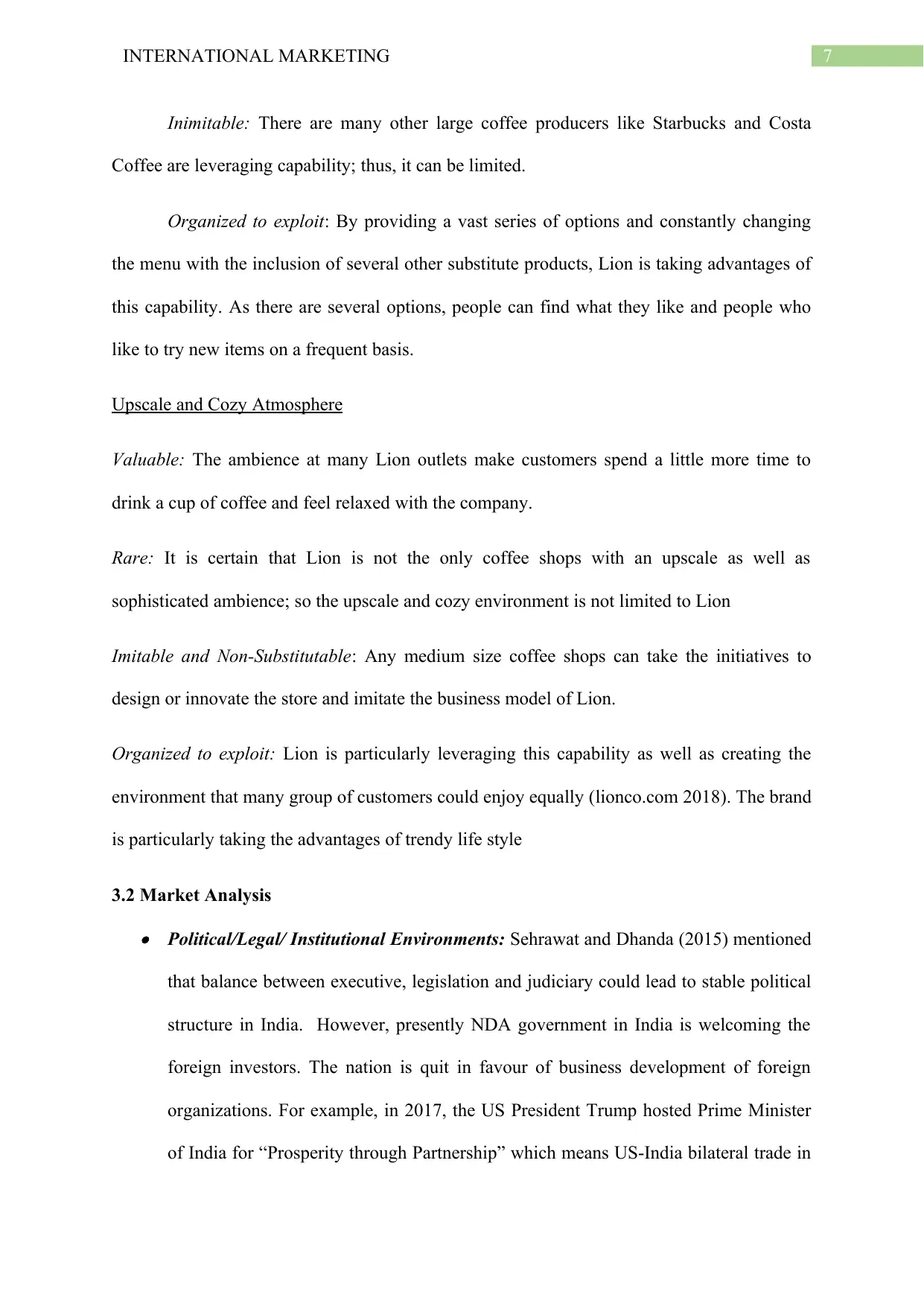
7INTERNATIONAL MARKETING
Inimitable: There are many other large coffee producers like Starbucks and Costa
Coffee are leveraging capability; thus, it can be limited.
Organized to exploit: By providing a vast series of options and constantly changing
the menu with the inclusion of several other substitute products, Lion is taking advantages of
this capability. As there are several options, people can find what they like and people who
like to try new items on a frequent basis.
Upscale and Cozy Atmosphere
Valuable: The ambience at many Lion outlets make customers spend a little more time to
drink a cup of coffee and feel relaxed with the company.
Rare: It is certain that Lion is not the only coffee shops with an upscale as well as
sophisticated ambience; so the upscale and cozy environment is not limited to Lion
Imitable and Non-Substitutable: Any medium size coffee shops can take the initiatives to
design or innovate the store and imitate the business model of Lion.
Organized to exploit: Lion is particularly leveraging this capability as well as creating the
environment that many group of customers could enjoy equally (lionco.com 2018). The brand
is particularly taking the advantages of trendy life style
3.2 Market Analysis Political/Legal/ Institutional Environments: Sehrawat and Dhanda (2015) mentioned
that balance between executive, legislation and judiciary could lead to stable political
structure in India. However, presently NDA government in India is welcoming the
foreign investors. The nation is quit in favour of business development of foreign
organizations. For example, in 2017, the US President Trump hosted Prime Minister
of India for “Prosperity through Partnership” which means US-India bilateral trade in
Inimitable: There are many other large coffee producers like Starbucks and Costa
Coffee are leveraging capability; thus, it can be limited.
Organized to exploit: By providing a vast series of options and constantly changing
the menu with the inclusion of several other substitute products, Lion is taking advantages of
this capability. As there are several options, people can find what they like and people who
like to try new items on a frequent basis.
Upscale and Cozy Atmosphere
Valuable: The ambience at many Lion outlets make customers spend a little more time to
drink a cup of coffee and feel relaxed with the company.
Rare: It is certain that Lion is not the only coffee shops with an upscale as well as
sophisticated ambience; so the upscale and cozy environment is not limited to Lion
Imitable and Non-Substitutable: Any medium size coffee shops can take the initiatives to
design or innovate the store and imitate the business model of Lion.
Organized to exploit: Lion is particularly leveraging this capability as well as creating the
environment that many group of customers could enjoy equally (lionco.com 2018). The brand
is particularly taking the advantages of trendy life style
3.2 Market Analysis Political/Legal/ Institutional Environments: Sehrawat and Dhanda (2015) mentioned
that balance between executive, legislation and judiciary could lead to stable political
structure in India. However, presently NDA government in India is welcoming the
foreign investors. The nation is quit in favour of business development of foreign
organizations. For example, in 2017, the US President Trump hosted Prime Minister
of India for “Prosperity through Partnership” which means US-India bilateral trade in
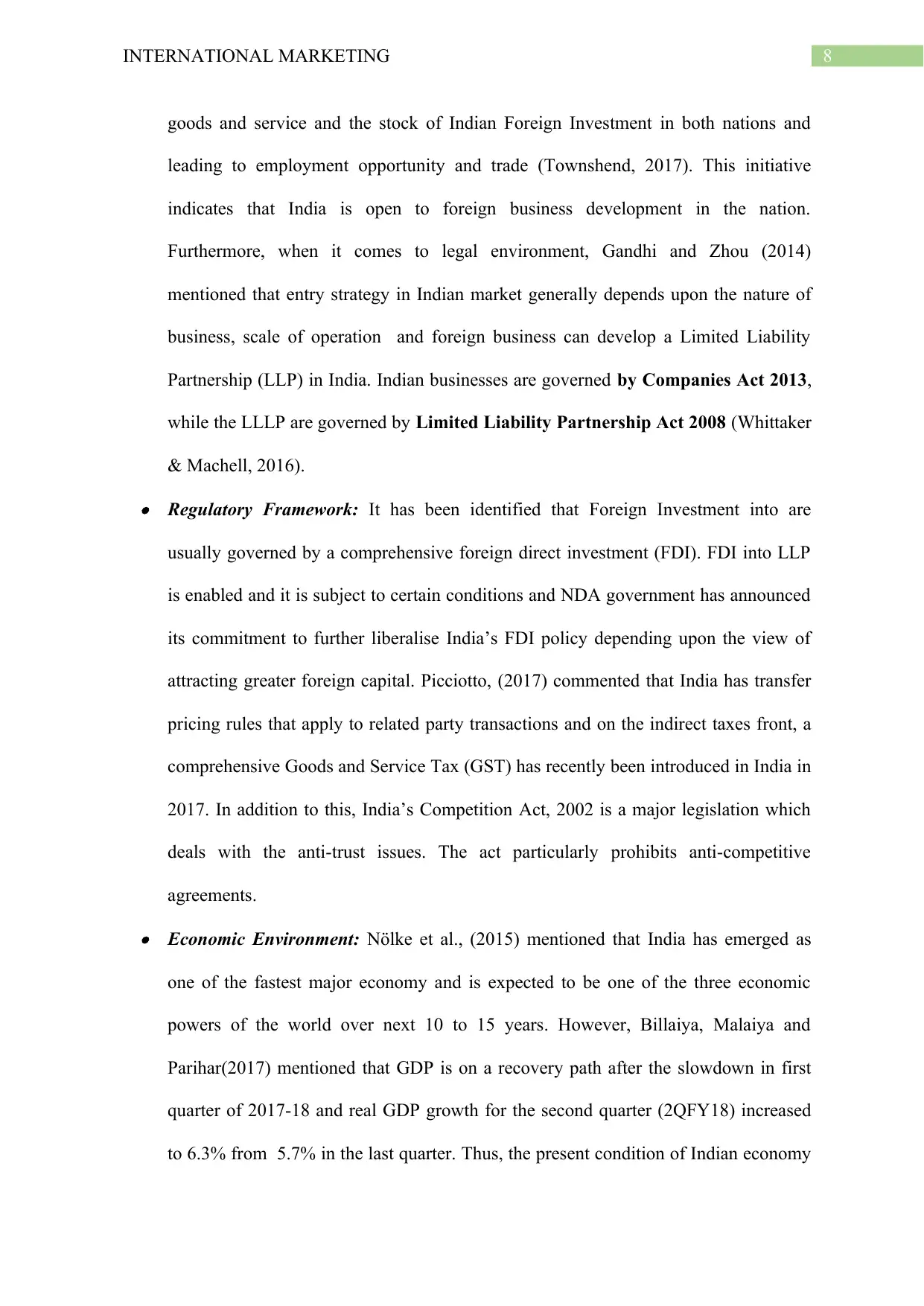
8INTERNATIONAL MARKETING
goods and service and the stock of Indian Foreign Investment in both nations and
leading to employment opportunity and trade (Townshend, 2017). This initiative
indicates that India is open to foreign business development in the nation.
Furthermore, when it comes to legal environment, Gandhi and Zhou (2014)
mentioned that entry strategy in Indian market generally depends upon the nature of
business, scale of operation and foreign business can develop a Limited Liability
Partnership (LLP) in India. Indian businesses are governed by Companies Act 2013,
while the LLLP are governed by Limited Liability Partnership Act 2008 (Whittaker
& Machell, 2016). Regulatory Framework: It has been identified that Foreign Investment into are
usually governed by a comprehensive foreign direct investment (FDI). FDI into LLP
is enabled and it is subject to certain conditions and NDA government has announced
its commitment to further liberalise India’s FDI policy depending upon the view of
attracting greater foreign capital. Picciotto, (2017) commented that India has transfer
pricing rules that apply to related party transactions and on the indirect taxes front, a
comprehensive Goods and Service Tax (GST) has recently been introduced in India in
2017. In addition to this, India’s Competition Act, 2002 is a major legislation which
deals with the anti-trust issues. The act particularly prohibits anti-competitive
agreements. Economic Environment: Nölke et al., (2015) mentioned that India has emerged as
one of the fastest major economy and is expected to be one of the three economic
powers of the world over next 10 to 15 years. However, Billaiya, Malaiya and
Parihar(2017) mentioned that GDP is on a recovery path after the slowdown in first
quarter of 2017-18 and real GDP growth for the second quarter (2QFY18) increased
to 6.3% from 5.7% in the last quarter. Thus, the present condition of Indian economy
goods and service and the stock of Indian Foreign Investment in both nations and
leading to employment opportunity and trade (Townshend, 2017). This initiative
indicates that India is open to foreign business development in the nation.
Furthermore, when it comes to legal environment, Gandhi and Zhou (2014)
mentioned that entry strategy in Indian market generally depends upon the nature of
business, scale of operation and foreign business can develop a Limited Liability
Partnership (LLP) in India. Indian businesses are governed by Companies Act 2013,
while the LLLP are governed by Limited Liability Partnership Act 2008 (Whittaker
& Machell, 2016). Regulatory Framework: It has been identified that Foreign Investment into are
usually governed by a comprehensive foreign direct investment (FDI). FDI into LLP
is enabled and it is subject to certain conditions and NDA government has announced
its commitment to further liberalise India’s FDI policy depending upon the view of
attracting greater foreign capital. Picciotto, (2017) commented that India has transfer
pricing rules that apply to related party transactions and on the indirect taxes front, a
comprehensive Goods and Service Tax (GST) has recently been introduced in India in
2017. In addition to this, India’s Competition Act, 2002 is a major legislation which
deals with the anti-trust issues. The act particularly prohibits anti-competitive
agreements. Economic Environment: Nölke et al., (2015) mentioned that India has emerged as
one of the fastest major economy and is expected to be one of the three economic
powers of the world over next 10 to 15 years. However, Billaiya, Malaiya and
Parihar(2017) mentioned that GDP is on a recovery path after the slowdown in first
quarter of 2017-18 and real GDP growth for the second quarter (2QFY18) increased
to 6.3% from 5.7% in the last quarter. Thus, the present condition of Indian economy
⊘ This is a preview!⊘
Do you want full access?
Subscribe today to unlock all pages.

Trusted by 1+ million students worldwide
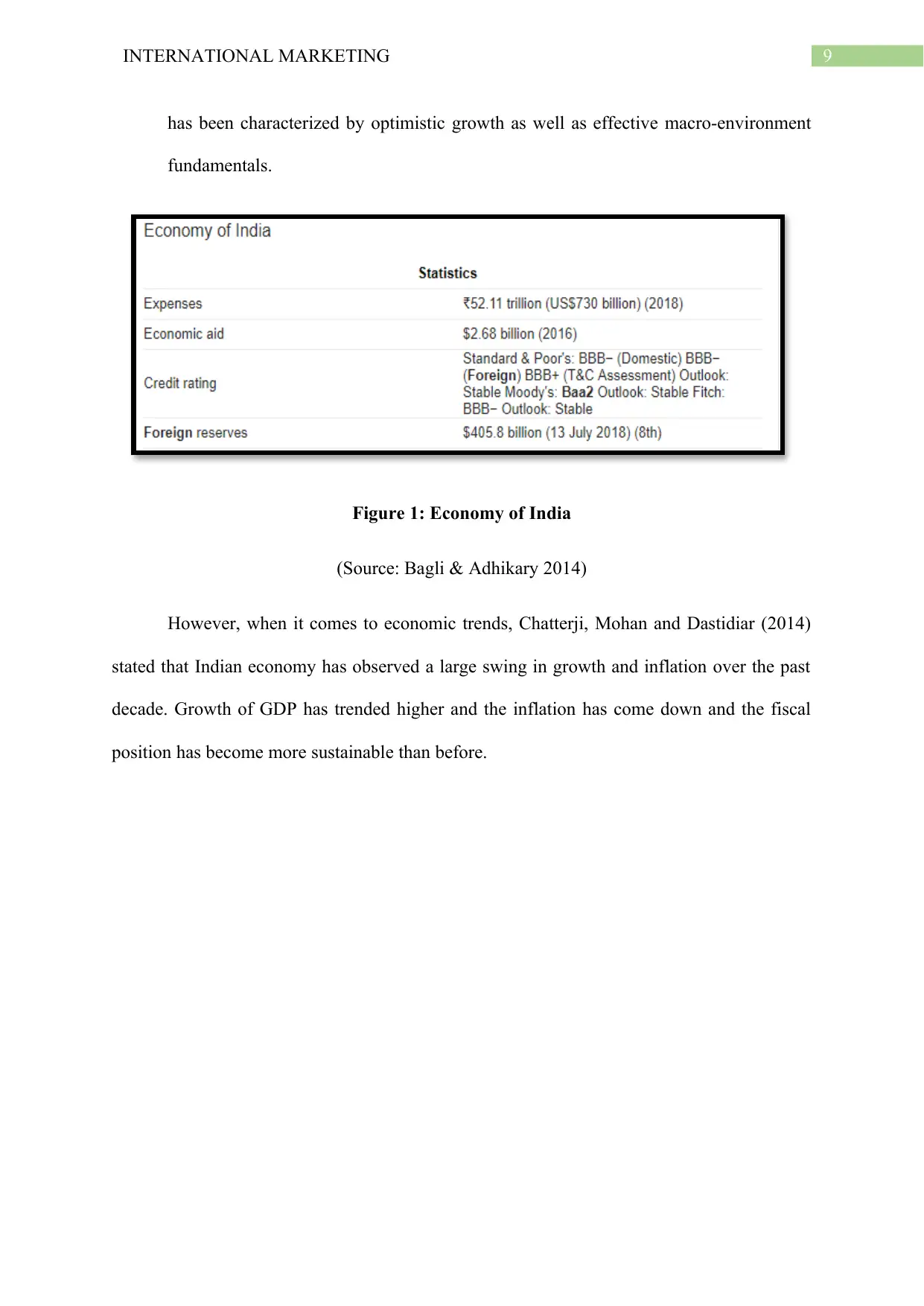
9INTERNATIONAL MARKETING
has been characterized by optimistic growth as well as effective macro-environment
fundamentals.
Figure 1: Economy of India
(Source: Bagli & Adhikary 2014)
However, when it comes to economic trends, Chatterji, Mohan and Dastidiar (2014)
stated that Indian economy has observed a large swing in growth and inflation over the past
decade. Growth of GDP has trended higher and the inflation has come down and the fiscal
position has become more sustainable than before.
has been characterized by optimistic growth as well as effective macro-environment
fundamentals.
Figure 1: Economy of India
(Source: Bagli & Adhikary 2014)
However, when it comes to economic trends, Chatterji, Mohan and Dastidiar (2014)
stated that Indian economy has observed a large swing in growth and inflation over the past
decade. Growth of GDP has trended higher and the inflation has come down and the fiscal
position has become more sustainable than before.
Paraphrase This Document
Need a fresh take? Get an instant paraphrase of this document with our AI Paraphraser
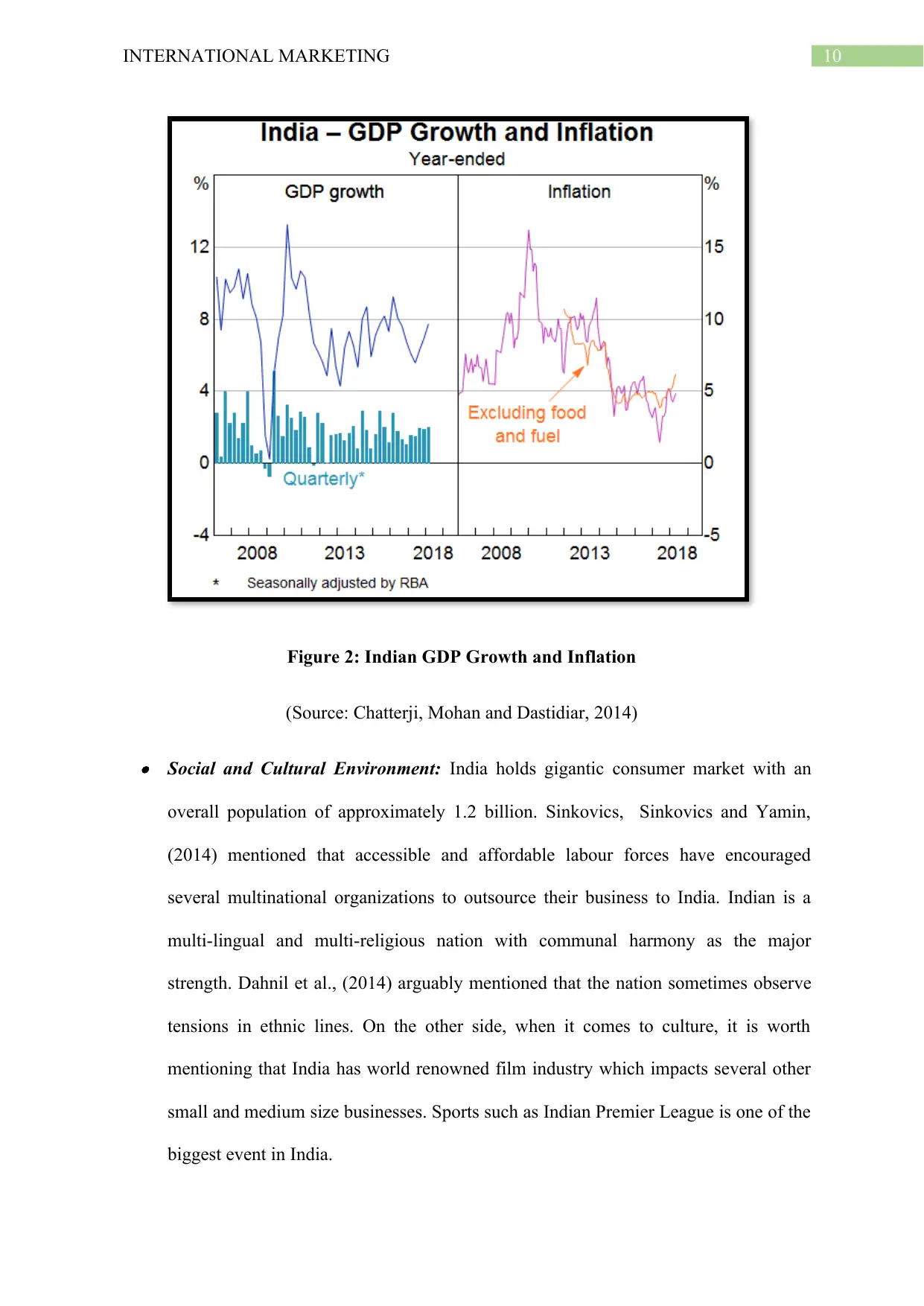
10INTERNATIONAL MARKETING
Figure 2: Indian GDP Growth and Inflation
(Source: Chatterji, Mohan and Dastidiar, 2014)
Social and Cultural Environment: India holds gigantic consumer market with an
overall population of approximately 1.2 billion. Sinkovics, Sinkovics and Yamin,
(2014) mentioned that accessible and affordable labour forces have encouraged
several multinational organizations to outsource their business to India. Indian is a
multi-lingual and multi-religious nation with communal harmony as the major
strength. Dahnil et al., (2014) arguably mentioned that the nation sometimes observe
tensions in ethnic lines. On the other side, when it comes to culture, it is worth
mentioning that India has world renowned film industry which impacts several other
small and medium size businesses. Sports such as Indian Premier League is one of the
biggest event in India.
Figure 2: Indian GDP Growth and Inflation
(Source: Chatterji, Mohan and Dastidiar, 2014)
Social and Cultural Environment: India holds gigantic consumer market with an
overall population of approximately 1.2 billion. Sinkovics, Sinkovics and Yamin,
(2014) mentioned that accessible and affordable labour forces have encouraged
several multinational organizations to outsource their business to India. Indian is a
multi-lingual and multi-religious nation with communal harmony as the major
strength. Dahnil et al., (2014) arguably mentioned that the nation sometimes observe
tensions in ethnic lines. On the other side, when it comes to culture, it is worth
mentioning that India has world renowned film industry which impacts several other
small and medium size businesses. Sports such as Indian Premier League is one of the
biggest event in India.
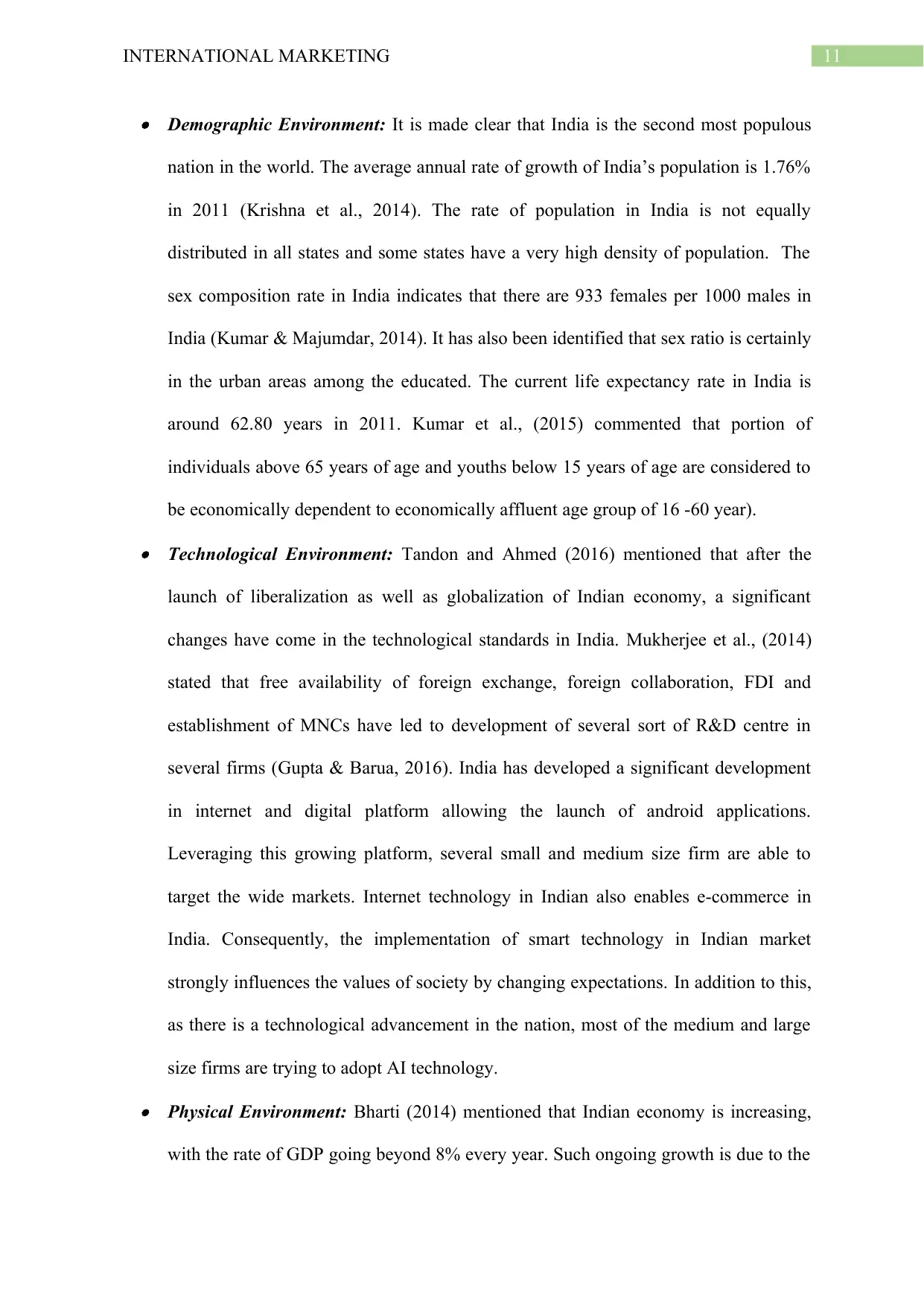
11INTERNATIONAL MARKETING
Demographic Environment: It is made clear that India is the second most populous
nation in the world. The average annual rate of growth of India’s population is 1.76%
in 2011 (Krishna et al., 2014). The rate of population in India is not equally
distributed in all states and some states have a very high density of population. The
sex composition rate in India indicates that there are 933 females per 1000 males in
India (Kumar & Majumdar, 2014). It has also been identified that sex ratio is certainly
in the urban areas among the educated. The current life expectancy rate in India is
around 62.80 years in 2011. Kumar et al., (2015) commented that portion of
individuals above 65 years of age and youths below 15 years of age are considered to
be economically dependent to economically affluent age group of 16 -60 year). Technological Environment: Tandon and Ahmed (2016) mentioned that after the
launch of liberalization as well as globalization of Indian economy, a significant
changes have come in the technological standards in India. Mukherjee et al., (2014)
stated that free availability of foreign exchange, foreign collaboration, FDI and
establishment of MNCs have led to development of several sort of R&D centre in
several firms (Gupta & Barua, 2016). India has developed a significant development
in internet and digital platform allowing the launch of android applications.
Leveraging this growing platform, several small and medium size firm are able to
target the wide markets. Internet technology in Indian also enables e-commerce in
India. Consequently, the implementation of smart technology in Indian market
strongly influences the values of society by changing expectations. In addition to this,
as there is a technological advancement in the nation, most of the medium and large
size firms are trying to adopt AI technology. Physical Environment: Bharti (2014) mentioned that Indian economy is increasing,
with the rate of GDP going beyond 8% every year. Such ongoing growth is due to the
Demographic Environment: It is made clear that India is the second most populous
nation in the world. The average annual rate of growth of India’s population is 1.76%
in 2011 (Krishna et al., 2014). The rate of population in India is not equally
distributed in all states and some states have a very high density of population. The
sex composition rate in India indicates that there are 933 females per 1000 males in
India (Kumar & Majumdar, 2014). It has also been identified that sex ratio is certainly
in the urban areas among the educated. The current life expectancy rate in India is
around 62.80 years in 2011. Kumar et al., (2015) commented that portion of
individuals above 65 years of age and youths below 15 years of age are considered to
be economically dependent to economically affluent age group of 16 -60 year). Technological Environment: Tandon and Ahmed (2016) mentioned that after the
launch of liberalization as well as globalization of Indian economy, a significant
changes have come in the technological standards in India. Mukherjee et al., (2014)
stated that free availability of foreign exchange, foreign collaboration, FDI and
establishment of MNCs have led to development of several sort of R&D centre in
several firms (Gupta & Barua, 2016). India has developed a significant development
in internet and digital platform allowing the launch of android applications.
Leveraging this growing platform, several small and medium size firm are able to
target the wide markets. Internet technology in Indian also enables e-commerce in
India. Consequently, the implementation of smart technology in Indian market
strongly influences the values of society by changing expectations. In addition to this,
as there is a technological advancement in the nation, most of the medium and large
size firms are trying to adopt AI technology. Physical Environment: Bharti (2014) mentioned that Indian economy is increasing,
with the rate of GDP going beyond 8% every year. Such ongoing growth is due to the
⊘ This is a preview!⊘
Do you want full access?
Subscribe today to unlock all pages.

Trusted by 1+ million students worldwide
1 out of 32
Related Documents
Your All-in-One AI-Powered Toolkit for Academic Success.
+13062052269
info@desklib.com
Available 24*7 on WhatsApp / Email
![[object Object]](/_next/static/media/star-bottom.7253800d.svg)
Unlock your academic potential
Copyright © 2020–2025 A2Z Services. All Rights Reserved. Developed and managed by ZUCOL.





